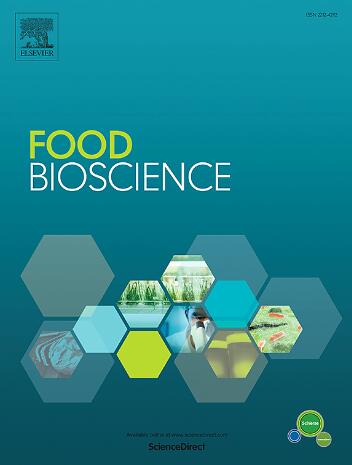Effects of Lactobacillus fermentation on the composition, existing forms, digestive characteristics, and antioxidant activity of polyphenols in three kinds of bean milk
IF 4.8
1区 农林科学
Q1 FOOD SCIENCE & TECHNOLOGY
引用次数: 0
Abstract
Soy, peanut and chickpea contain polyphenols that have multiple beneficial biological activities. In this work, two Lactobacillus strains were employed to ferment the three kinds of bean milk and the effects of fermentation on the polyphenols in them were investigated. After fermentation with L. fermentum GD01 and L. plantarum BHP03, the total phenolic contents were increased by 16.90 % and 14.64 % in soy milk, 18.14 % and 24.28 % in peanut milk, 46.39 % and 51.91 % in chickpea milk, respectively. Specifically, the contents of free phenol, insoluble ester phenol, and insoluble glycosidic phenol increased, while the contents of soluble ester phenol and soluble glycosidic phenol reduced. These changes were positively associated with the antioxidant activities. Further, Lactobacillus fermentation also changed the contents and forms of monomeric phenols in bean milk, with the free monomeric phenols exhibiting the greatest diversity in types. In addition, the fermented bean milk demonstrated a higher release of phenols compared to the unfermented counterparts during simulated digestion, resulting in enhanced antioxidant activities. Notably, the most substantial increase in soluble phenols was detected in fermented chickpea milk (162.66 % by GD01, 137.48 % by BHP03), while the most significant increase in insoluble phenols was observed in fermented peanut milk (147.46 % by GD01, 150.53 % by BHP03). All the results confirmed that Lactobacillus fermentation could alter the structures, compositions, digestive characteristics of the polyphenols in the three kinds of bean milk, ultimately enhancing their antioxidant activities. These results offer a theoretical foundation for the advancement of fermented bean milk products with enhanced biological activity.
乳杆菌发酵对三种豆浆中多酚的组成、存在形态、消化特性及抗氧化活性的影响
大豆、花生和鹰嘴豆含有多酚,具有多种有益的生物活性。本研究采用两种乳酸杆菌菌株对三种豆浆进行发酵,并研究了发酵对其中多酚的影响。经 L. fermentum GD01 和 L. plantarum BHP03 发酵后,豆奶中的总酚含量分别增加了 16.90 % 和 14.64 %,花生奶中分别增加了 18.14 % 和 24.28 %,鹰嘴豆奶中分别增加了 46.39 % 和 51.91 %。具体来说,游离酚、不溶性酯酚和不溶性糖苷酚的含量增加,而可溶性酯酚和可溶性糖苷酚的含量减少。这些变化与抗氧化活性呈正相关。此外,乳酸菌发酵还改变了豆奶中单体酚的含量和形式,其中游离单体酚的类型最为多样。此外,在模拟消化过程中,发酵豆奶比未发酵豆奶释放出更多的酚类物质,从而增强了抗氧化活性。值得注意的是,发酵鹰嘴豆奶中可溶性酚的增幅最大(GD01 为 162.66%,BHP03 为 137.48%),而发酵花生奶中不溶性酚的增幅最大(GD01 为 147.46%,BHP03 为 150.53%)。所有结果都证实,乳酸菌发酵可以改变三种豆奶中多酚的结构、组成和消化特性,最终提高它们的抗氧化活性。这些结果为提高发酵豆奶产品的生物活性提供了理论依据。
本文章由计算机程序翻译,如有差异,请以英文原文为准。
求助全文
约1分钟内获得全文
求助全文
来源期刊

Food Bioscience
Biochemistry, Genetics and Molecular Biology-Biochemistry
CiteScore
6.40
自引率
5.80%
发文量
671
审稿时长
27 days
期刊介绍:
Food Bioscience is a peer-reviewed journal that aims to provide a forum for recent developments in the field of bio-related food research. The journal focuses on both fundamental and applied research worldwide, with special attention to ethnic and cultural aspects of food bioresearch.
 求助内容:
求助内容: 应助结果提醒方式:
应助结果提醒方式:


